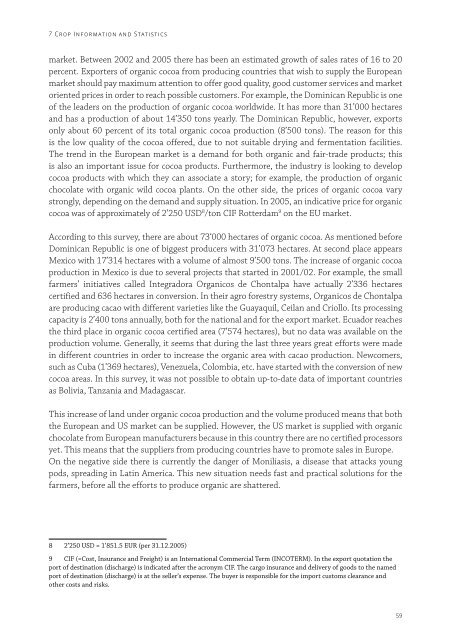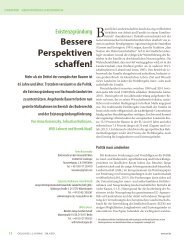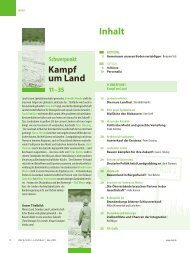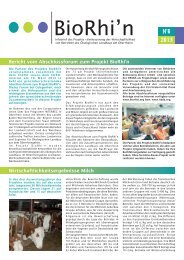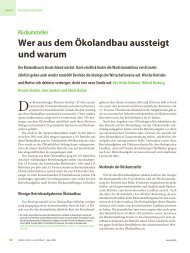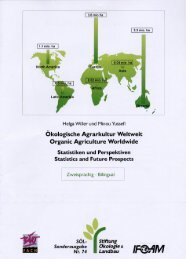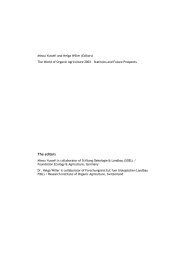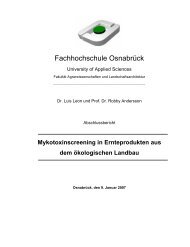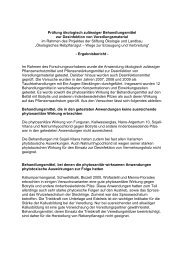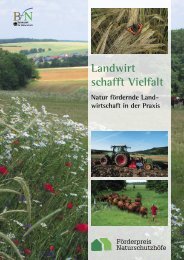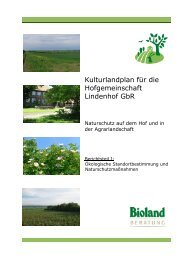the world of organic agriculture - Organic Eprints
the world of organic agriculture - Organic Eprints
the world of organic agriculture - Organic Eprints
Create successful ePaper yourself
Turn your PDF publications into a flip-book with our unique Google optimized e-Paper software.
7 Crop Information and Statistics<br />
market. Between 2002 and 2005 <strong>the</strong>re has been an estimated growth <strong>of</strong> sales rates <strong>of</strong> 16 to 20<br />
percent. Exporters <strong>of</strong> <strong>organic</strong> cocoa from producing countries that wish to supply <strong>the</strong> European<br />
market should pay maximum attention to <strong>of</strong>fer good quality, good customer services and market<br />
oriented prices in order to reach possible customers. For example, <strong>the</strong> Dominican Republic is one<br />
<strong>of</strong> <strong>the</strong> leaders on <strong>the</strong> production <strong>of</strong> <strong>organic</strong> cocoa <strong>world</strong>wide. It has more than 31’000 hectares<br />
and has a production <strong>of</strong> about 14’350 tons yearly. The Dominican Republic, however, exports<br />
only about 60 percent <strong>of</strong> its total <strong>organic</strong> cocoa production (8’500 tons). The reason for this<br />
is <strong>the</strong> low quality <strong>of</strong> <strong>the</strong> cocoa <strong>of</strong>fered, due to not suitable drying and fermentation facilities.<br />
The trend in <strong>the</strong> European market is a demand for both <strong>organic</strong> and fair-trade products; this<br />
is also an important issue for cocoa products. Fur<strong>the</strong>rmore, <strong>the</strong> industry is looking to develop<br />
cocoa products with which <strong>the</strong>y can associate a story; for example, <strong>the</strong> production <strong>of</strong> <strong>organic</strong><br />
chocolate with <strong>organic</strong> wild cocoa plants. On <strong>the</strong> o<strong>the</strong>r side, <strong>the</strong> prices <strong>of</strong> <strong>organic</strong> cocoa vary<br />
strongly, depending on <strong>the</strong> demand and supply situation. In 2005, an indicative price for <strong>organic</strong><br />
cocoa was <strong>of</strong> approximately <strong>of</strong> 2’250 USD 8 /ton CIF Rotterdam 9 on <strong>the</strong> EU market.<br />
According to this survey, <strong>the</strong>re are about 73‘000 hectares <strong>of</strong> <strong>organic</strong> cocoa. As mentioned before<br />
Dominican Republic is one <strong>of</strong> biggest producers with 31’073 hectares. At second place appears<br />
Mexico with 17’314 hectares with a volume <strong>of</strong> almost 9’500 tons. The increase <strong>of</strong> <strong>organic</strong> cocoa<br />
production in Mexico is due to several projects that started in 2001/02. For example, <strong>the</strong> small<br />
farmers’ initiatives called Integradora <strong>Organic</strong>os de Chontalpa have actually 2’336 hectares<br />
certified and 636 hectares in conversion. In <strong>the</strong>ir agro forestry systems, <strong>Organic</strong>os de Chontalpa<br />
are producing cacao with different varieties like <strong>the</strong> Guayaquil, Ceilan and Criollo. Its processing<br />
capacity is 2’400 tons annually, both for <strong>the</strong> national and for <strong>the</strong> export market. Ecuador reaches<br />
<strong>the</strong> third place in <strong>organic</strong> cocoa certified area (7’574 hectares), but no data was available on <strong>the</strong><br />
production volume. Generally, it seems that during <strong>the</strong> last three years great efforts were made<br />
in different countries in order to increase <strong>the</strong> <strong>organic</strong> area with cacao production. Newcomers,<br />
such as Cuba (1’369 hectares), Venezuela, Colombia, etc. have started with <strong>the</strong> conversion <strong>of</strong> new<br />
cocoa areas. In this survey, it was not possible to obtain up-to-date data <strong>of</strong> important countries<br />
as Bolivia, Tanzania and Madagascar.<br />
This increase <strong>of</strong> land under <strong>organic</strong> cocoa production and <strong>the</strong> volume produced means that both<br />
<strong>the</strong> European and US market can be supplied. However, <strong>the</strong> US market is supplied with <strong>organic</strong><br />
chocolate from European manufacturers because in this country <strong>the</strong>re are no certified processors<br />
yet. This means that <strong>the</strong> suppliers from producing countries have to promote sales in Europe.<br />
On <strong>the</strong> negative side <strong>the</strong>re is currently <strong>the</strong> danger <strong>of</strong> Moniliasis, a disease that attacks young<br />
pods, spreading in Latin America. This new situation needs fast and practical solutions for <strong>the</strong><br />
farmers, before all <strong>the</strong> efforts to produce <strong>organic</strong> are shattered.<br />
8 2’250 USD = 1’851.5 EUR (per 31.12.2005)<br />
9 CIF (=Cost, Insurance and Freight) is an International Commercial Term (INCOTERM). In <strong>the</strong> export quotation <strong>the</strong><br />
port <strong>of</strong> destination (discharge) is indicated after <strong>the</strong> acronym CIF. The cargo insurance and delivery <strong>of</strong> goods to <strong>the</strong> named<br />
port <strong>of</strong> destination (discharge) is at <strong>the</strong> seller‘s expense. The buyer is responsible for <strong>the</strong> import customs clearance and<br />
o<strong>the</strong>r costs and risks.<br />
59


